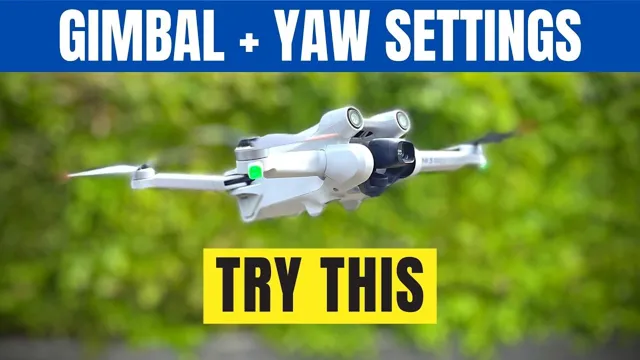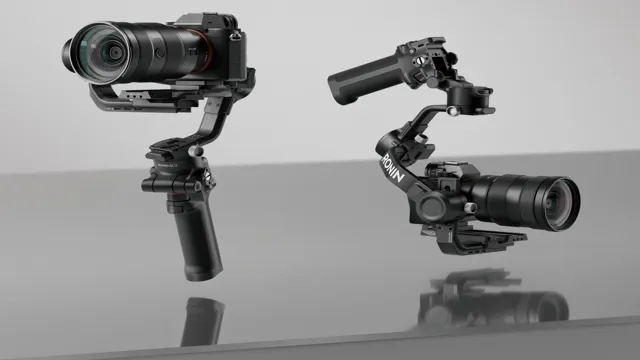Are you experiencing unsteady and shaky footage in your DJI Mini 3 Pro? This could be a sign that your gimbal needs calibration. Proper calibration is essential to ensure maximum stability and performance of your drone’s camera. In this blog post, we’ll guide you through the step-by-step process of calibrating your DJI Mini 3 Pro gimbal.
Like a painter who needs to have a steady hand, your drone’s camera needs a stable platform to capture smooth video footage and sharp images. Let’s dive into the details of how to calibrate your DJI Mini 3 Pro gimbal, and get stable, steady results from your aerial photography.
Overview of Gimbal Calibration
Calibrating the gimbal on your DJI Mini 3 Pro is an important step in ensuring smooth and stable footage. The gimbal is responsible for stabilizing your camera while in flight, and if it’s not properly calibrated, you may end up with shaky and unusable footage. Fortunately, calibrating the gimbal on the DJI Mini 3 Pro is a relatively simple process.
Start by making sure the drone is on level ground and the camera is facing straight ahead. Then, go into the settings and select “calibrate gimbal.” Follow the prompts and the drone will automatically calibrate the gimbal for you.
It’s important to calibrate the gimbal every time you change location or before each flight to ensure the best possible footage. So don’t forget to take a few extra minutes before takeoff to perform this crucial step.
Why it’s important
Gimbal calibration is an essential process for any drone pilot looking to capture stable, smooth footage. Essentially, a gimbal is a device that keeps the camera steady and level despite any movement or shake from the drone itself. Without proper calibration, the gimbal may not be able to adequately compensate for the drone’s motions, leading to shaky or distorted footage.
This is why gimbal calibration is so important. By correctly balancing the gimbal, the pilot can ensure smooth and stable footage, allowing them to capture professional-grade visuals that will wow their clients. So, next time you’re preparing for a drone shoot, don’t forget the importance of gimbal calibration.
Your clients will thank you!

When to do it
Gimbal calibration is an essential process for ensuring smooth and stable footage capturing with your camera. Knowing when to calibrate your gimbal is important to maintain optimal performance and prevent any wear and tear. Generally, it is recommended to calibrate your gimbal when you notice any inconsistencies in its movements or if it has been dropped or roughly handled.
Additionally, calibration should be performed periodically as routine maintenance, especially when using the gimbal frequently. A well-calibrated gimbal is critical to achieving clear and stable footage that will impress your audience. So, don’t ignore this essential step in maximizing the performance of your gimbal and camera.
Step-by-step Gimbal Calibration Process
If you’ve recently acquired a DJI Mini 3 Pro drone and want to get the most out of its gimbal, you’ll need to calibrate it properly. This process isn’t too difficult, but it may take some time and patience to get it right. Firstly, ensure that your drone is flat on a level surface and that its propellers are removed.
Open the DJI Fly app on your mobile device and select “Gimbal” from the main menu. Tap on “Gimbal Auto Calibration” to start the automated process. Once that’s complete, go to the “Gimbal Advanced Settings” menu and select “Gimbal Calibration”.
Follow the on-screen instructions to tilt and rotate your drone in different directions until the calibration is complete. After this, you can test your drone’s gimbal by flying it and ensuring that the video captured is stable and free from jerky movements. With this simple process, you can ensure that your DJI Mini 3 Pro drone’s gimbal is fully calibrated and ready to capture smooth and seamless footage, making your aerial photography experience all the more enjoyable!
Prepare your drone for calibration
If you’re looking to get the most out of your drone’s camera, then it’s important to perform a gimbal calibration. This process ensures that the camera is properly aligned and helps to eliminate any shaky footage that might be caused by an uncalibrated gimbal. To begin the calibration process, start by ensuring that your drone’s battery is fully charged and the drone is on a level surface.
Next, remove the gimbal cover and make sure that the camera is properly attached. Finally, follow the instructions in your drone’s manual or on the manufacturer’s website to complete the calibration process. This may involve connecting to your drone’s app and adjusting settings, moving the drone into different positions, or using a calibration tool.
Once the calibration is complete, your drone’s camera will be ready to capture smoother, more stable footage. Make sure to perform a gimbal calibration on a regular basis to ensure that your camera continues to function properly and produce the best possible footage.
Calibrate your gimbal on the DJI Fly app
Gimbal calibration is a crucial step before flying your DJI drone, and luckily, it’s easily done through the DJI Fly app. By calibrating your gimbal, you ensure that your camera remains level and stable throughout your flight, resulting in smooth and cinematic footage. To begin the process, make sure your drone is on a flat surface, and then open the DJI Fly app.
Under “Camera Settings,” select “Gimbal Calibration,” and follow the on-screen instructions. These will typically involve holding the drone steady while it moves through a series of motions to calibrate the gimbal. Once completed, you should see a message confirming the successful calibration.
It’s essential to calibrate your gimbal regularly, especially if you notice any issues with your footage. Investing in a stable gimbal can make a significant impact on the quality of your drone footage.
Check the results of the calibration
After completing the step-by-step Gimbal calibration process, it’s important to check the results to ensure that everything is working properly. Begin by checking the levelness of the camera. If it’s tilting to one side or the other, you may need to recalibrate.
Next, check the stability of the camera. Move the camera around to see if it wobbles or shakes. If it does, you’ll need to make some adjustments.
Finally, test the camera’s movement in all directions. If it’s moving too fast or too slow, or if it’s jerky, you may need to adjust the settings until everything is smooth and steady. By carefully checking the results of the calibration, you can ensure that your gimbal is working at its best, allowing you to capture smooth and stable footage every time.
Tips and Tricks for Successful Gimbal Calibration
Calibrating the gimbal on a DJI Mini 3 Pro is crucial to ensuring smooth and stable footage. To start the calibration process, make sure the drone is on a flat surface and the gimbal protection cover is removed. Then, go to the DJI Fly app and select the camera settings.
From there, click on advanced settings and select gimbal auto calibration. Follow the on-screen instructions and wait for the calibration process to finish. Additionally, make sure to regularly check the gimbal for any debris or dirt that may affect its performance.
Proper and timely calibration can prevent shaky footage and ensure that your footage comes out smooth and jitter-free. Remember to take care of your equipment, and it will take care of you!
Check for firmware updates
If you’re experiencing issues with your gimbal, chances are it might need calibration. One important step in the calibration process is to check for firmware updates. Firmware updates can address bugs or stability issues and improve the overall performance of your gimbal.
Make sure to check the manufacturer’s website or app for any available updates and follow the instructions carefully to install them. It’s also a good idea to check for updates regularly to ensure your gimbal is always up-to-date. With a simple firmware update, you may find that your gimbal’s performance improves drastically, making your filming experience smoother and more enjoyable.
Don’t neglect this critical step in the calibration process!
Avoid calibrating in windy conditions
Calibrating your gimbal can be a tricky and time-consuming process, but it’s essential to ensure smooth, stable footage. One of the most important tips for successful gimbal calibration is to avoid doing it in windy conditions. Windy conditions can throw off the balance of the gimbal, making it harder to calibrate correctly.
If you’re outdoors and the wind is gusting, it’s best to wait for calmer conditions before attempting to calibrate your gimbal. Even a slight breeze can make a big difference, so it’s best to err on the side of caution. By waiting for calm conditions, you’ll be able to calibrate your gimbal more accurately, resulting in better, steadier footage.
So remember, when it comes to gimbal calibration, calm conditions are your best friend.
Conclusion and Final Thoughts
To achieve the smoothest and most stable footage possible, calibrating the gimbal on your DJI Mini 3 Pro is crucial. But fear not, it’s not rocket science! With just a few simple steps, you can ensure that your drone’s camera will stay level and steady, no matter how much wind or turbulence you encounter. So grab your DJI Mini 3 Pro, a flat surface, and a bit of patience, and get ready to take your aerial videography to the next level.
And who knows, with your newly calibrated gimbal, maybe you’ll even become the next Spielberg of the skies!”
FAQs
What is gimbal calibration on DJI Mini 3 Pro?
Gimbal calibration on DJI Mini 3 Pro is the process of restoring the gimbal to a level position. This helps in reducing the shaking effect while recording videos and enhances the stability of the shots.
How to calibrate the gimbal on DJI Mini 3 Pro?
To calibrate the gimbal on DJI Mini 3 Pro, follow the steps listed below:
– Make sure the drone is turned off.
– Remove the lens cover and place the drone on a level surface.
– Power on the drone and wait for the gimbal to initialize.
– Access the gimbal settings from the DJI Fly app and select ‘Gimbal Auto Calibration’.
– Follow the on-screen instructions to complete the calibration process.
Why is gimbal calibration important on DJI Mini 3 Pro?
Gimbal calibration is important on DJI Mini 3 Pro as it helps in maintaining the stability of the camera and ensures smooth, stable footage. A calibrated gimbal reduces the chances of shaky footage and prevents unwanted camera movements.
How often should the gimbal be calibrated on DJI Mini 3 Pro?
It is recommended to calibrate the gimbal on DJI Mini 3 Pro before each flight. However, if you notice any shakiness or abnormal camera movements during the flight, re-calibration may be required.

